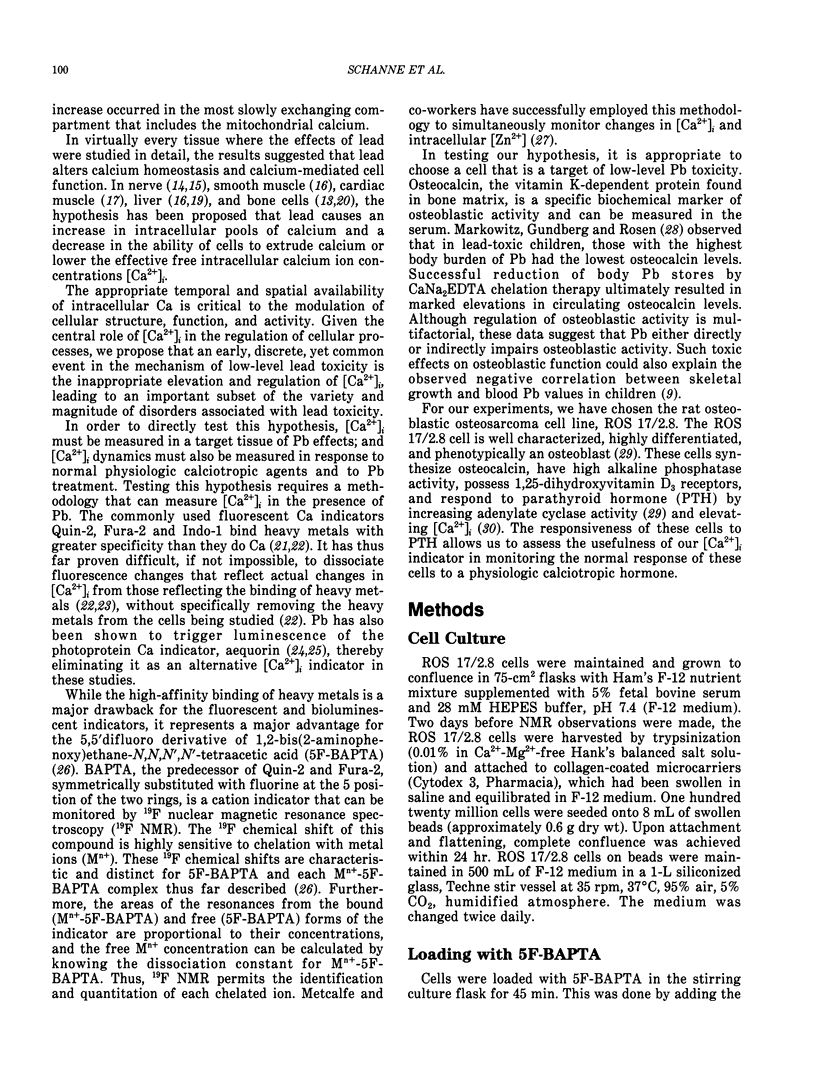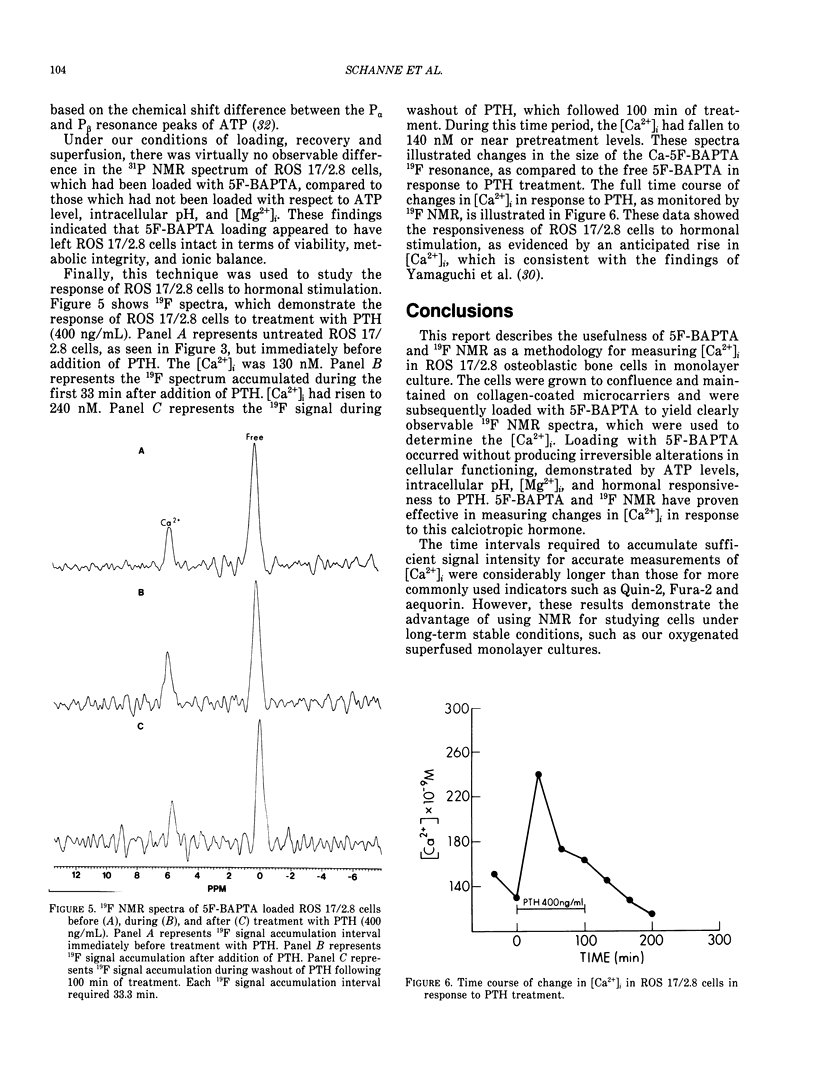Abstract
Lead (Pb) has been shown to perturb cellular calcium (Ca) homeostasis, altering sizes and flux rates of cellular pools of exchangeable Ca and impairing Ca-mediated cell processes. To date, however, a direct effect of Pb on intracellular-free Ca2+ has not yet been demonstrated. Heavy metals bind to the commonly used fluorescent Ca ion indicators with greater affinity than does Ca and thereby interfere with the expected Ca-dependent fluorescence. In this study, the fluorinated Ca ion indicator, 1,2-bis(2-amino-5-fluorophenoxy)ethane N,N,N',N'-tetraacetic acid (5F-BAPTA), and 19F NMR were used to measure the free intracellular Ca ion concentration ([Ca2+]i) in the rat osteoblastic bone cell line, ROS 17/2.8. Both Pb and Ca bind to 5F-BAPTA with high affinity, but the Pb-5F-BAPTA comple produces a 19F NMR signal at a chemical shift distinct from 5F-BAPTA and the Ca-5F-BAPTA complex. The apparent dissociation constants for Pb-5F-BAPTA and Ca-5F-BAPTA are 2 X 10(-10) M and 5 X 10(-7) M, respectively, at 30 degrees C, pH 7.1, and Mg2+ (0.5 mM). Thus, this methodology allows for the simultaneous identification and quantification of free Pb and free Ca ion concentrations. Determinations of [Ca2+]i were based on 19F NMR measurements of 5F-BAPTA-loaded ROS 17/2.8 osteoblastic bone cells that were attached to collagen-coated microcarrier beads. Cells were continuously superfused with freshly oxygenated medium at 30 degrees C. Under these conditions, the [Ca2+]i of ROS 17/2.8 cells was observed to be 128 +/- 14 nM.(ABSTRACT TRUNCATED AT 250 WORDS)
Full text
PDF







Selected References
These references are in PubMed. This may not be the complete list of references from this article.
- Arslan P., Di Virgilio F., Beltrame M., Tsien R. Y., Pozzan T. Cytosolic Ca2+ homeostasis in Ehrlich and Yoshida carcinomas. A new, membrane-permeant chelator of heavy metals reveals that these ascites tumor cell lines have normal cytosolic free Ca2+. J Biol Chem. 1985 Mar 10;260(5):2719–2727. [PubMed] [Google Scholar]
- Atchison W. D., Narahashi T. Mechanism of action of lead on neuromuscular junctions. Neurotoxicology. 1984 Fall;5(3):267–282. [PubMed] [Google Scholar]
- Bellinger D., Leviton A., Waternaux C., Needleman H., Rabinowitz M. Longitudinal analyses of prenatal and postnatal lead exposure and early cognitive development. N Engl J Med. 1987 Apr 23;316(17):1037–1043. doi: 10.1056/NEJM198704233161701. [DOI] [PubMed] [Google Scholar]
- Connor J. A. Digital imaging of free calcium changes and of spatial gradients in growing processes in single, mammalian central nervous system cells. Proc Natl Acad Sci U S A. 1986 Aug;83(16):6179–6183. doi: 10.1073/pnas.83.16.6179. [DOI] [PMC free article] [PubMed] [Google Scholar]
- Cooper G. P., Suszkiw J. B., Manalis R. S. Heavy metals: effects on synaptic transmission. Neurotoxicology. 1984 Fall;5(3):247–266. [PubMed] [Google Scholar]
- Davis J. M., Svendsgaard D. J. Lead and child development. Nature. 1987 Sep 24;329(6137):297–300. doi: 10.1038/329297a0. [DOI] [PubMed] [Google Scholar]
- Grynkiewicz G., Poenie M., Tsien R. Y. A new generation of Ca2+ indicators with greatly improved fluorescence properties. J Biol Chem. 1985 Mar 25;260(6):3440–3450. [PubMed] [Google Scholar]
- Gupta R. K., Gupta P., Moore R. D. NMR studies of intracellular metal ions in intact cells and tissues. Annu Rev Biophys Bioeng. 1984;13:221–246. doi: 10.1146/annurev.bb.13.060184.001253. [DOI] [PubMed] [Google Scholar]
- Harlan W. R., Landis J. R., Schmouder R. L., Goldstein N. G., Harlan L. C. Blood lead and blood pressure. Relationship in the adolescent and adult US population. JAMA. 1985 Jan 25;253(4):530–534. doi: 10.1001/jama.253.4.530. [DOI] [PubMed] [Google Scholar]
- Izutsu K. T., Felton S. P., Siegel I. A., Yoda W. T., Chen A. C. Aequorin: its ionic specificity. Biochem Biophys Res Commun. 1972 Nov 15;49(4):1034–1039. doi: 10.1016/0006-291x(72)90316-6. [DOI] [PubMed] [Google Scholar]
- Kopp S. J., Glonek T., Erlanger M., Perry E. F., Perry H. M., Jr, Bárány M. Cadmium and lead effects on myocardial function and metabolism. J Environ Pathol Toxicol. 1980 Sep;4(2-3):205–227. [PubMed] [Google Scholar]
- Levy L. A., Murphy E., London R. E. Synthesis and characterization of 19F NMR chelators for measurement of cytosolic free Ca. Am J Physiol. 1987 Apr;252(4 Pt 1):C441–C449. doi: 10.1152/ajpcell.1987.252.4.C441. [DOI] [PubMed] [Google Scholar]
- Marban E., Kitakaze M., Kusuoka H., Porterfield J. K., Yue D. T., Chacko V. P. Intracellular free calcium concentration measured with 19F NMR spectroscopy in intact ferret hearts. Proc Natl Acad Sci U S A. 1987 Aug;84(16):6005–6009. doi: 10.1073/pnas.84.16.6005. [DOI] [PMC free article] [PubMed] [Google Scholar]
- Metcalfe J. C., Hesketh T. R., Smith G. A. Free cytosolic Ca2+ measurements with fluorine labelled indicators using 19FNMR. Cell Calcium. 1985 Apr;6(1-2):183–195. doi: 10.1016/0143-4160(85)90043-0. [DOI] [PubMed] [Google Scholar]
- Murphy E., Levy L., Berkowitz L. R., Orringer E. P., Gabel S. A., London R. E. Nuclear magnetic resonance measurement of cytosolic free calcium levels in human red blood cells. Am J Physiol. 1986 Oct;251(4 Pt 1):C496–C504. doi: 10.1152/ajpcell.1986.251.4.C496. [DOI] [PubMed] [Google Scholar]
- Piomelli S., Rosen J. F., Chisolm J. J., Jr, Graef J. W. Management of childhood lead poisoning. J Pediatr. 1984 Oct;105(4):523–532. doi: 10.1016/s0022-3476(84)80414-x. [DOI] [PubMed] [Google Scholar]
- Pirkle J. L., Schwartz J., Landis J. R., Harlan W. R. The relationship between blood lead levels and blood pressure and its cardiovascular risk implications. Am J Epidemiol. 1985 Feb;121(2):246–258. doi: 10.1093/oxfordjournals.aje.a113995. [DOI] [PubMed] [Google Scholar]
- Pounds J. G. Effect of lead intoxication on calcium homeostasis and calcium-mediated cell function: a review. Neurotoxicology. 1984 Fall;5(3):295–331. [PubMed] [Google Scholar]
- Pounds J. G., Morrison D., Wright R., Casciano D. A., Shaddock J. G. Effect of lead on calcium-mediated cell function in the isolated rat hepatocyte. Toxicol Appl Pharmacol. 1982 May;63(3):402–408. doi: 10.1016/0041-008x(82)90269-1. [DOI] [PubMed] [Google Scholar]
- Pounds J. G., Wright R., Morrison D., Casciano D. A. Effect of lead on calcium homeostasis in the isolated rat hepatocyte. Toxicol Appl Pharmacol. 1982 May;63(3):389–401. doi: 10.1016/0041-008x(82)90268-x. [DOI] [PubMed] [Google Scholar]
- Rosen J. F., Pounds J. G. Quantitative interactions between Pb2+ and Ca2+ homeostasis in cultured osteoclastic bone cells. Toxicol Appl Pharmacol. 1989 May;98(3):530–543. doi: 10.1016/0041-008x(89)90181-6. [DOI] [PubMed] [Google Scholar]
- Rosen J. F. The metabolism of lead in isolated bone cell populations: interactions between lead and calcium. Toxicol Appl Pharmacol. 1983 Oct;71(1):101–112. doi: 10.1016/0041-008x(83)90049-2. [DOI] [PubMed] [Google Scholar]
- Schanne F. A., Dowd T. L., Gupta R. K., Rosen J. F. Lead increases free Ca2+ concentration in cultured osteoblastic bone cells: simultaneous detection of intracellular free Pb2+ by 19F NMR. Proc Natl Acad Sci U S A. 1989 Jul;86(13):5133–5135. doi: 10.1073/pnas.86.13.5133. [DOI] [PMC free article] [PubMed] [Google Scholar]
- Schwartz J., Angle C., Pitcher H. Relationship between childhood blood lead levels and stature. Pediatrics. 1986 Mar;77(3):281–288. [PubMed] [Google Scholar]
- Shimomura O., Johnson F. H. Further data on the specificity of aequorin luminescence to calcium. Biochem Biophys Res Commun. 1973 Jul 17;53(2):490–494. doi: 10.1016/0006-291x(73)90688-8. [DOI] [PubMed] [Google Scholar]
- Smith G. A., Hesketh R. T., Metcalfe J. C., Feeney J., Morris P. G. Intracellular calcium measurements by 19F NMR of fluorine-labeled chelators. Proc Natl Acad Sci U S A. 1983 Dec;80(23):7178–7182. doi: 10.1073/pnas.80.23.7178. [DOI] [PMC free article] [PubMed] [Google Scholar]
- Tsien R. Y. New calcium indicators and buffers with high selectivity against magnesium and protons: design, synthesis, and properties of prototype structures. Biochemistry. 1980 May 27;19(11):2396–2404. doi: 10.1021/bi00552a018. [DOI] [PubMed] [Google Scholar]
- Yamaguchi D. T., Hahn T. J., Iida-Klein A., Kleeman C. R., Muallem S. Parathyroid hormone-activated calcium channels in an osteoblast-like clonal osteosarcoma cell line. cAMP-dependent and cAMP-independent calcium channels. J Biol Chem. 1987 Jun 5;262(16):7711–7718. [PubMed] [Google Scholar]
- Yushok W. D., Gupta R. K. Phosphocreatine in Ehrlich ascites tumor cells detected by noninvasive 31P NMR spectroscopy. Biochem Biophys Res Commun. 1980 Jul 16;95(1):73–81. doi: 10.1016/0006-291x(80)90706-8. [DOI] [PubMed] [Google Scholar]


